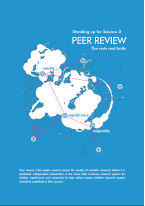Peer Review: The Nuts and Bolts
Using a collection of concerns raised by their peers, Sense about Science’s Voices of Young Scientists writing team set off to interview scientists, journal editors, grant bodies’ representatives, patient group workers and journalists in the UK and around the world to find out how peer review works, the challenges for peer review and how to get involved.

Sense About Science a charitable trust that equips people to make sense of scientific and medical claims in public discussion.
We have not avoided criticisms of the peer review process in this guide but rather entered into the debate, asking journal editors and reviewers some challenging questions about scientific fraud and plagiarism going undetected; issues of trust and bias; ground-breaking research taking years to publish and the system benefiting a closed group of scientists.
This guide will help early career researchers understand:
1. How the peer review process works
2. Some of the limitations of peer review
3. The role of peer review in society
Peer review: the nuts and boltswas launched in July 2012 at the EuroScience Open Forum in Dublin alongside a call from VoYS members to the Higher Education Funding Council of England to recognize reviewing as part of the Research Excellence Framework.


































































































